Artificial intelligence and climate change represent two ways humans are destroying life as we know it on Earth. But the former can also help us reduce the consequences of the latter.
The California Department of Forestry and Fire Protection (Cal Fire) has introduced a new program that uses AI to detect wildfires and even prevent them as they occur. Created in partnership with the University of California San Diego, the Alert California AI program picks up signals from 1,032 cameras that rotate 360 degrees and uses artificial intelligence to identify anomalies in camera images. It then notifies the emergency services and other authorities to check whether a possible fire requires intervention.
The program, launched in July, has already stopped at least one potential wildfire, Reuters reported. A camera reportedly recorded the start of a new fire at 3am in the remote Cleveland National Forest east of San Diego. The AI noticed these flames and alerted a fire captain who “called in about 60 firefighters, including seven engines, two bulldozers, two water tankers and two hand crews.” Cal Fire said the flames were extinguished in 45 minutes.

The Alert California tech website says it uses LiDAR scans from airplanes and drones to generate “equally precise, three-dimensional information about scanned surfaces.” This information is combined with the physical characteristics of tree species to learn more about California’s forest biomass and carbon content. Cal Fire says its machine learning model uses petabytes of data from cameras to distinguish between smoke and other airborne particles.
The system was developed using artificial intelligence by UCSD engineers of the California-based company DigitalPath. Cal Fire has invested over $20 million in the program over the past four years and promises an additional $3,516,000 in the near future.
“We’re in an extreme climate right now,” said UCSD professor of geology and geophysics Neal Driscoll, who serves as the program’s principal investigator. That’s why we give them the data, because this problem is bigger than any of us. “We need to use technology to help move the pointer even a little bit,” he says. However, Driscoll adds that the available sample size is too small to determine the overall effectiveness of the program.